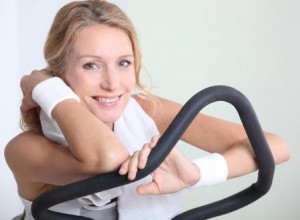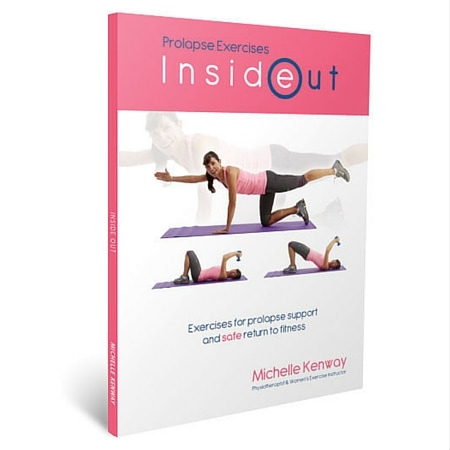How to choose the best pelvic prolapse exercises for staying in shape and maintaining your fitness? Sometimes it’s really difficult to get a clear straightforward answer about safe prolapse exercises.

Fortunately if you’ve been diagnosed with a prolapse, or if you’ve had prolapse surgery it’s definitely not the beginning of the end! Rather it’s a wake-up call to consider how exercise impacts upon your body and to start choosing suitable pelvic prolapse exercises.
Spinning and cycling are both terrific pelvic prolapse exercises, and both are usually very well suited to women seeking pelvic floor safe exercises.
This expert article helps you exercise with a prolapse with solutions for how to exercise effectively and minimise pressure on your pelvic floor (and your prolapse):
- Benefits of cycling
- Which pelvic prolapse exercises for fitness?
- What is spinning?
- How to cycle with a prolapse
- How to spin with a prolapse
- How to lose weight cycling
- Cycling and bone density
- Cycling and pelvic pain.
Prolapse Exercises e-Book
International best selling prolapse exercise guide for women with prolapse and after prolapse surgery.
Prolapse Exercises teaches you how to:
- Exercise safely after prolapse surgery
- Reduce your risk or repeat prolapse
- Avoid unsafe exercises
- Choose pelvic floor safe exercises
- Reduce your risk of prolapse worsening
- Improve prolapse support
- Increase your strength and fitness
- Strengthen your core
- Lose weight
Benefits of Cycling
A wonderful feature of cycling and spinning exercise is that it helps you to exercise and support your pelvic floor. This support can allow you to exercise at higher levels of intensity which is great, especially if you are seeking to improve your fitness or lose weight.
Cycling exercise can help you:
- Maintain or improve your fitness (energy and endurance)
- Manage your body weight
- Strengthen your legs
- Reduce your risk of some serious diseases (heart disease, stroke, diabetes)
- Protect your pelvic floor and your pelvic prolapse
- Support your pelvic floor exercising after prolapse surgery
- Protect your knees and hips as you exercise
- Manage stress, anxiety and depression.
Which Pelvic Prolapse Exercises for Fitness?
When chosing from the huge variety of fitness exercises available, consider cycling and spinning if yo have a prolapse or with prvious prolapse surgery.

Cycling and spinning are great fitness and weight management exercises. Cycling and spinning are also low impact exercises; low impact exercises place the least pressure on your pelvic floor and prolapse during exercise. In fact with outdoor cycling and spinning there is very minimal impact at all.
What is Spinning?
Spinning is a form of cycling usually conducted indoors on a stationary exercise bike. Spinning is a popular form of group exercise performed to music. The spin instructor usually guides class participants through a range of imagined cycling tracks from flat high speed work to heavy climbing. There are some considerations for spinning exercise with a prolapse listed below.
How to Cycle With a Pelvic Prolapse
Cycling is usually a comfortable exercise for women with mild to moderate prolapse. Cycling is also usually an appropriate exercise for women long-term after prolapse surgery unless otherwise advised by their surgeon.
One of the great features of cycling is that it allows you to exercise for extended periods of time to improve your endurance, and burn fat. This contrasts to high impact forms of exercise which often cause prolapse symptoms when prolonged.
How to Fit Your Bike
Ensure that your bike is well fitted and suited to your body:
- Upright cycling with higher handle bars is better suited to women prone to back or neck pain; try to avoid leaning too far forward if you are prone to back or neck pain.
- When sitting in the saddle, your extended (straightened) leg should have only a slight bend at your knee; your knee should not straighten completely, or bend too much.
- Adjust the tilt of your bike seat so that your weight is transmitted evenly through your sit bones, the same as when you sit in a chair
- Gel bike seat covers can help to cushion the seat, if it feels to hard. Alternatively soft cushioned seats can quite readily be fitted. Padded bike pants can also help to improve sitting comfort when cycling.
Tips for Cycling With a Pelvic Prolapse
These tips are designed to help you minimise pressure on your pelvic floor with cycling:
- Use light gears to avoid intense leg work
- Cycle on flat to gently undulating surfaces; avoid steep climbing hills to avoid prolapse strain.
- Return to cycling gradually after prolapse surgery when you have approval to do so from your surgeon, commence with short duration cycling and only according to your level of comfort.
- Progress cycling very gradually after prolapse surgery, and you may choose to commence cycling on 1-2 days per week. If you suffer ongoing discomfort when sitting on the bike seat, cease cycling and consult your doctor.
- Balance is a consideration for cycling, if your balance is decreased then you may wish to commence using a stationary cycle as an alternative. Be mindful of the fact that your balance may be somewhat decreased after prolapse surgery recovery.
Spinning With a Pelvic Prolapse
Spinning affords women with prolapse the ability to exercise at high intensity to get a really great workout. Spinning can help you to increase your fitness, lose weight and reduce stress levels. This provides women with an ideal alternative to running, for women who may have been runners prior to their prolapse diagnosis.
Important considerations prior to commencing spinning for prolapse exercise:
- Use light gears for all spinning; always avoid heavy gears (and straining)
- Stay seated in the bike seat; avoid standing out of the saddle during spin climbing tracks and stay seated instead
- Avoid spinning classes in the early months after prolapse repair surgery; when you have approval to return to cycling, commence with a stationary bike and pace yourself rather than risk overdoing things in a group exercise spin class.
- Return to spinning gradually after prolapse surgery; gradually progress the time you spend in the saddle and the intensity of your exercise.
- Spinning can be a high intensity form of exercise; if you have never exercised before or if you have general health problems seek your doctor’s approval before commencing spin classes.
Weight Loss Exercise for Prolapse and Cycling
Stationary cycling is an effective weight loss exercise for women when performed at the right intensity. Recent studies show that 20 minute sessions of high and low intensity stationary cycling are more effective for weight loss and abdominal fat reduction in women than longer sessions of moderate intensity exercise. Intensity is a key factor in promoting weight loss, and cycling allows women with a prolapse and after prolapse surgery to exercise at higher levels of intensity and protect their pelvic floor.
Cycling and Bone Density
Cycling will not improve your bone density. Cycling is a low impact form of exercise, and low impact exercises have no positive effect on bone density for women. If you are exercising for bone health with a prolapse, appropriate pelvic floor safe strength training exercises can help complement your cycling fitness exercise and help you to exercise for your bone health too.
Chronic Pelvic Pain and Cycling
Cycling is not an appropriate exercise for women suffering chronic pelvic pain. If you suffer from chronic pelvic pain or pelvic floor muscle tension, avoid cycling as sitting on the bike seat can aggravate these conditions. Most women can cycle safely however if you have or are at increased risk of pelvic pain, cycling and spinning should be avoided.
For women with prolapse and after prolapse surgery, cycling helps overcome the challenge posed for safe fitness and weight loss exercise. The pelvic floor support provided by bike riding allows women to exercise effectively for both their fitness and weight loss, making cycling without doubt one of the best pelvic prolapse exercises for women.







